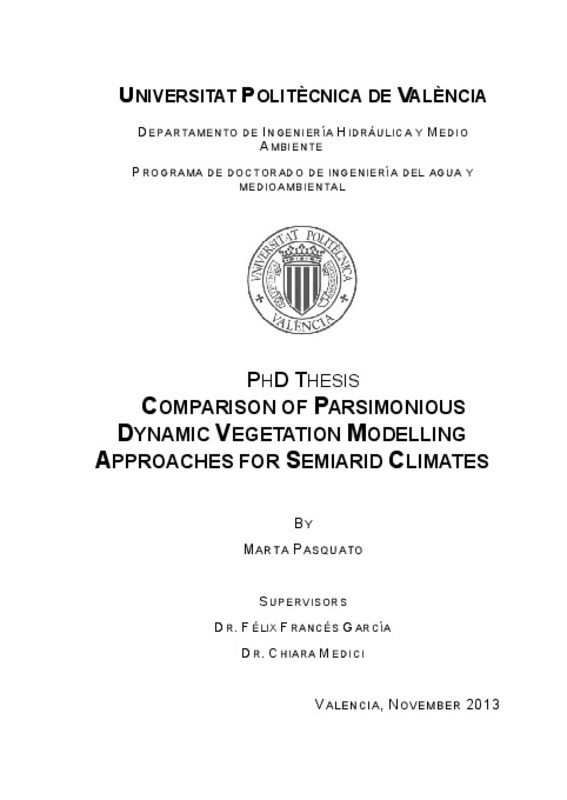- RiuNet repositorio UPV
- :
- Investigación
- :
- Tesis doctorales
- :
- Ver ítem
JavaScript is disabled for your browser. Some features of this site may not work without it.
Buscar en RiuNet
Listar
Mi cuenta
Estadísticas
Ayuda RiuNet
Admin. UPV
Comparison of parsimonious dynamic vegetation modelling approaches for semiarid climates
Mostrar el registro sencillo del ítem
Ficheros en el ítem
| dc.contributor.advisor | Francés García, Félix Ramón
|
es_ES |
| dc.contributor.advisor | Medici, Chiara
|
es_ES |
| dc.contributor.author | Pasquato, Marta
|
es_ES |
| dc.date.accessioned | 2013-12-05T11:55:55Z | |
| dc.date.available | 2013-12-05T11:55:55Z | |
| dc.date.created | 2013-11-18T10:45:00Z | es_ES |
| dc.date.issued | 2013-12-05T11:55:52Z | es_ES |
| dc.identifier.uri | http://hdl.handle.net/10251/34326 | |
| dc.description.abstract | A large portion of Earth¿s terrestrial surface is subject to arid climatic water stress. As in these regions the hydrological cycle and the vegetation dynamics are tightly interconnected, a coupled modeling of these two systems is needed to fully reproduce the ecosystems¿ behavior over time and to predict possible future responses to climate change. In this thesis, the performance of three parsimonious dynamic vegetation models, suitable for inclusion in an operational ecohydrological model, are tested in a semi-arid Aleppo pine forest area in the south-east of Spain. The first model considered, HORAS (Quevedo & Francés, 2008), simulates growth as a function of plant transpiration (T), evaluating environmental restraints through the transpiration-reference evapotranspiration ratio. The state variable related to vegetation is R, relative foliar biomass, which is equivalent to FAO crop coefficient (Allen et al., 1998), but not fixed in time. The HORAS model was then abandoned because of its unsatisfactory results, probably due to a poor simulation of evaporation and transpiration processes. As for the other two models, WUE-model and LUE-model, the state variable is the leaf biomass (Bl, kg dry mass m-2 vegetation cover). Both models simulate gross primary production (GPP), in the first case as a function of transpiration and water use efficiency (WUE), in the second case as a function of absorbed photosynthetically active radiation (APAR) and light use efficiency (LUE). Net primary production (NPP) is then calculated taking into account respiration. The modelling is focused particularly on simulating foliar biomass, which is obtained from NPP through an allocation equation based on the maximum leaf area index (LAI) sustainable by the system, and considering turnover. An analysis of the information offered by MODIS EVI, NDVI, and LAI products was also performed, in order to investigate vegetation dynamics in the study site and to select the best indices to be used as observational verification for models. MODIS EVI is reported in literature (Huete et al., 2002) to be highly correlated with leaf biomass. In accordance with the phenological cycle timing described for the Aleppo pine in similar climates (Muñoz et al., 2003), the EVI showed maximum values in spring and minimum values in winter. Similar results were found applying the aforementioned WUE- and LUE- models to the study area. Contrasting simulated LAI with the EVI series, the correlation coefficients rWUE = 0.45 and rLUE = 0.57 were found for the WUE-model and LUE-model respectively. Concerning NDVI, its own definition links this index to the ¿greenness¿ of the target, so that it appears highly linked to chlorophyll content and vegetation condition, but only indirectly related to LAI. Photosynthetic pigment concentrations are reported to be sensitive to water stress in Aleppo pine (Baquedano and Castillo, 2006) so, to compare the models¿ results with NDVI, the simulated LAI was corrected by plant water-stress. The resulting correlation coefficients were rWUE = 0.62 and rLUE = 0.59. Lastly, MODIS LAI and ET were found to be unreliable in the study area because very low compared to field data and to values reported in literature (e.g. Molina & del Campo, 2012) for the same species in similar climatic conditions. The performance of both WUE- and LUE- models in this semi-arid region is found to be reasonable. However, the LUE-model presents the advantages of a better performance, the possibility to be used in a wider range of climates and to have been extensively tested in literature. | en_EN |
| dc.language | Inglés | es_ES |
| dc.publisher | Universitat Politècnica de València | es_ES |
| dc.rights | Reserva de todos los derechos | es_ES |
| dc.source | Riunet | es_ES |
| dc.subject | Semiarid climate | es_ES |
| dc.subject | Pinus halepensis | es_ES |
| dc.subject | NDVI | es_ES |
| dc.subject | EVI | es_ES |
| dc.subject | LAI | es_ES |
| dc.subject | Parsimonious model | es_ES |
| dc.subject | Vegetation | es_ES |
| dc.subject | Satellite data | es_ES |
| dc.subject | MODIS | es_ES |
| dc.subject.classification | INGENIERIA HIDRAULICA | es_ES |
| dc.title | Comparison of parsimonious dynamic vegetation modelling approaches for semiarid climates | |
| dc.type | Tesis doctoral | es_ES |
| dc.identifier.doi | 10.4995/Thesis/10251/34326 | es_ES |
| dc.rights.accessRights | Abierto | es_ES |
| dc.contributor.affiliation | Universitat Politècnica de València. Departamento de Ingeniería Hidráulica y Medio Ambiente - Departament d'Enginyeria Hidràulica i Medi Ambient | es_ES |
| dc.description.bibliographicCitation | Pasquato, M. (2013). Comparison of parsimonious dynamic vegetation modelling approaches for semiarid climates [Tesis doctoral no publicada]. Universitat Politècnica de València. https://doi.org/10.4995/Thesis/10251/34326 | es_ES |
| dc.description.accrualMethod | TESIS | es_ES |
| dc.type.version | info:eu-repo/semantics/acceptedVersion | es_ES |
| dc.relation.tesis | 7266 | es_ES |
Este ítem aparece en la(s) siguiente(s) colección(ones)
-
Tesis doctorales [5193]







![MS Word file [Word]](/themes/UPV/images/msword.png)

